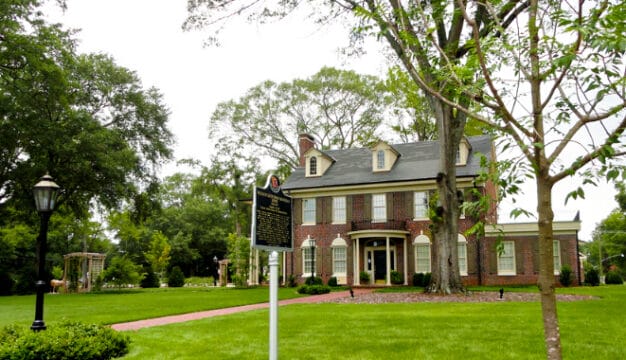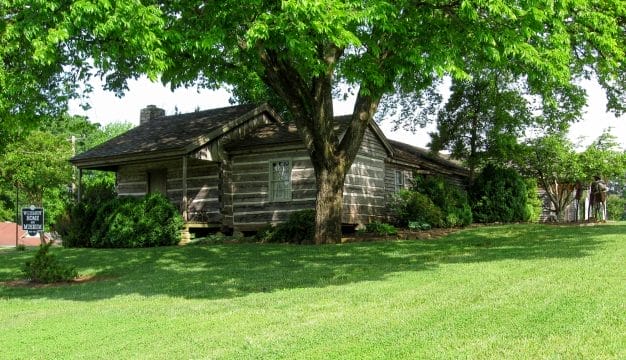Battle of Holy Ground
The Battle of Holy Ground, which took place on December 23, 1813, was a major battle in Creek War of 1813-14. At the Holy Ground, the Red Sticks, a Creek traditionalist faction led by William Weatherford and others, fought local militia and federal troops, under the command of Brig. Gen. Ferdinand Claiborne, who were ostensibly fighting as allies of the Creek National Council.
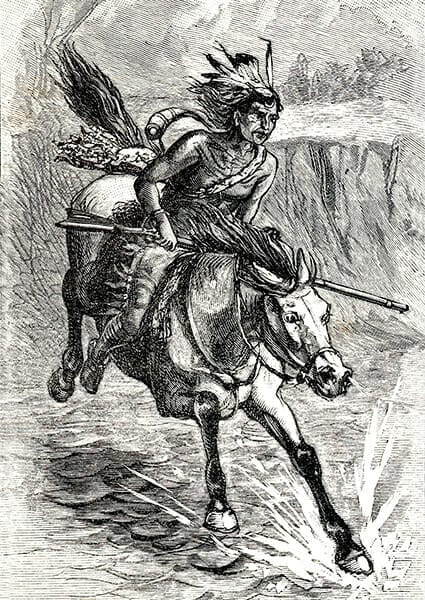 Weatherford’s Leap
Holy Ground, or Econochaca in the Creek’s Muskogean language, was a settlement located on the bluffs above the Alabama River, approximately 30 miles west of present-day Montgomery. The encampment was established in the summer of 1813 by Josiah Francis. Eccanacnaca or Econochaca, although usually translated as “Holy Ground,” is more properly “sacred or beloved ground.” It was one of three new settlements erected by Red Sticks in the summer of 1813—one for each component of the Upper Creek Nation (Alabamas, Tallapoosas, Abeikas). The Tallapoosas built a new settlement near the town of Autossee, and the Abeikas erected Tohopeka, a fortified encampment at the Horseshoe Bend of the Tallapoosa River. The Holy Ground was the defensive gathering place for the Alabamas. The Red Sticks erected stakes and other defensive obstacles at the high bluff location. In addition, the Creek prophets undertook ceremonies to establish a spiritual barrier that they believed would have the power to destroy any white man who passed through it.
Weatherford’s Leap
Holy Ground, or Econochaca in the Creek’s Muskogean language, was a settlement located on the bluffs above the Alabama River, approximately 30 miles west of present-day Montgomery. The encampment was established in the summer of 1813 by Josiah Francis. Eccanacnaca or Econochaca, although usually translated as “Holy Ground,” is more properly “sacred or beloved ground.” It was one of three new settlements erected by Red Sticks in the summer of 1813—one for each component of the Upper Creek Nation (Alabamas, Tallapoosas, Abeikas). The Tallapoosas built a new settlement near the town of Autossee, and the Abeikas erected Tohopeka, a fortified encampment at the Horseshoe Bend of the Tallapoosa River. The Holy Ground was the defensive gathering place for the Alabamas. The Red Sticks erected stakes and other defensive obstacles at the high bluff location. In addition, the Creek prophets undertook ceremonies to establish a spiritual barrier that they believed would have the power to destroy any white man who passed through it.
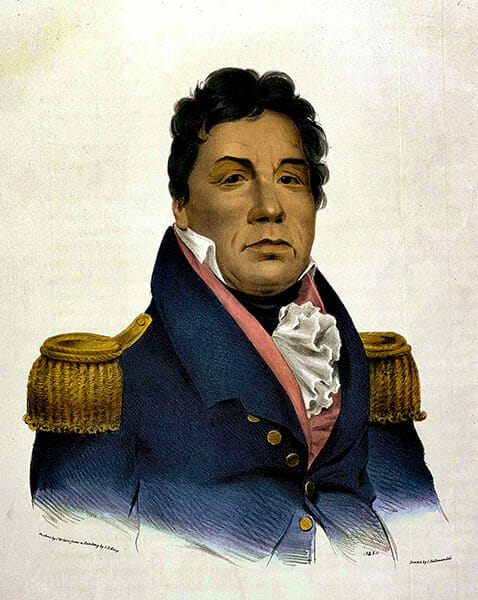 Pushmataha
The events at Burnt Corn, which took place in late July, and the subsequent Fort Mims massacre in late August sparked terror and calls for retaliation among the white settlers of what was then the Mississippi Territory. What had begun as a civil war among the Creeks had thus become an American war against the Red Sticks. After the defeat at Burnt Corn, Claiborne, under orders from Gen. Thomas Flournoy, had begun raising troops from his post at Mount Vernon, north of Mobile, in what would become Mobile County. After Fort Mims, he became even more determined to crush the Red Stick movement. Initially, Claiborne had difficulty in gathering troops, but by late October, he had raised several hundred militiamen and other soldiers to join his men in the Third U.S. Infantry. Claiborne was able to rally support among the Choctaw by calling on them to support the United States. Their leader, Pushmataha, convinced some 150 Choctaw warriors to join Claiborne’s force of about 850.
Pushmataha
The events at Burnt Corn, which took place in late July, and the subsequent Fort Mims massacre in late August sparked terror and calls for retaliation among the white settlers of what was then the Mississippi Territory. What had begun as a civil war among the Creeks had thus become an American war against the Red Sticks. After the defeat at Burnt Corn, Claiborne, under orders from Gen. Thomas Flournoy, had begun raising troops from his post at Mount Vernon, north of Mobile, in what would become Mobile County. After Fort Mims, he became even more determined to crush the Red Stick movement. Initially, Claiborne had difficulty in gathering troops, but by late October, he had raised several hundred militiamen and other soldiers to join his men in the Third U.S. Infantry. Claiborne was able to rally support among the Choctaw by calling on them to support the United States. Their leader, Pushmataha, convinced some 150 Choctaw warriors to join Claiborne’s force of about 850.
Claiborne ‘s target, Econochaca, represented the largest concentrations of Red Stick warriors, with sizeable stores of corn and other goods, and had been the staging ground for the attack on Fort Mims. By July 1813, Benjamin Hawkins estimated that 320 warriors were there. By the end of the year, the settlement was said to consist of possibly 200 houses.
In early November, Claiborne and his force of almost 1,000 men began moving up the Alabama River toward Econochaca, stopping briefly at several points along the way. After several weeks of marching through difficult terrain and under terrible weather conditions, they had come within 100 miles of Econochaca and constructed a stockade, which they named Fort Claiborne. On December 13, Claiborne and his men began the march to the settlement, setting up camp 10 miles south on December 22.
As would become Creek custom, the Red Sticks, led by William Weatherford, evacuated women and children from the town upon receiving word of the American advance. Claiborne divided his men under Colonel Gilbert Russell, who led the Third Infantry, and Major Joseph Carson, who headed the militia. This column reached the town first and traded fire with the Red Stick defenders. As the Americans breached the sacred barrier unharmed, many Red Sticks fled the site; Weatherford and roughly 120 Creek warriors remained to defend the town, as did a sizeable force of African Americans, some of whom were former slaves who had escaped Fort Mims with the Red Sticks. The battle raged for almost an hour, with the Red Stick warriors and their African American allies slowly falling back toward the river.
The Americans failed to encircle the town completely, however, and most of the Red Sticks escaped. Weatherford, a noted horseman, escaped by riding his horse Arrow over the 15-foot-high river bluff in a hail of gunfire.
After the Red Sticks’ retreat, Claiborne’s men took the town and discovered scalps taken by the Red Sticks at Fort Mims and considerable stores of food, which the poorly supplied American army carried off before leaving the Choctaws to pillage the town and burn it. Between 20 and 30 Red Sticks were killed in the engagement, including a dozen African Americans who were living among them. Claiborne lost one man, with 20 wounded. In the days immediately after the battle, Claiborne’s army burned other Creek camps and then retreated to Mount Vernon, where it was mustered out of service.
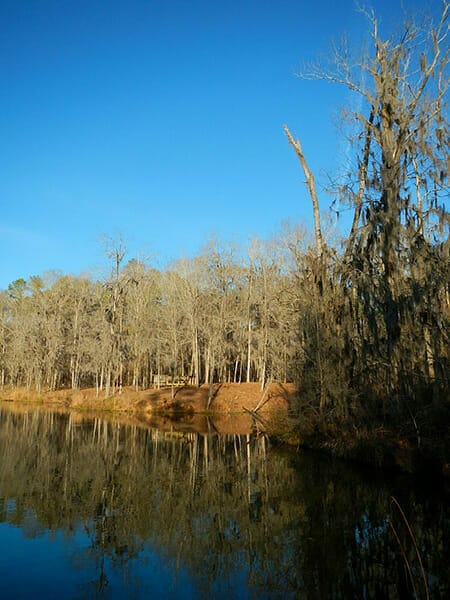 Holy Ground Battlefield Park
In military terms, Claiborne’s campaign yielded poor results in terms of enemy casualties, but the loss of supplies no doubt created hardship for the Creek people. The Americans—and later historians—have often derided the prophets and their “magical” preparations prior to battle. But the failure of the spiritual barrier at Holy Ground seems not to have disheartened the Red Sticks, who continued to gather in massive defensive concentrations to await American attacks. Like the earlier Canoe Fight, the Battle of Holy Ground was the source of one of several events that entered popular mythology during the Creek War, as stories of Weatherford’s leap spread and became embellished. Today, the battle is commemorated at Holy Ground Battlefield Park in White Hall, Lowndes County. The site features interpretive signs and trails that lead to the famous bluff.
Holy Ground Battlefield Park
In military terms, Claiborne’s campaign yielded poor results in terms of enemy casualties, but the loss of supplies no doubt created hardship for the Creek people. The Americans—and later historians—have often derided the prophets and their “magical” preparations prior to battle. But the failure of the spiritual barrier at Holy Ground seems not to have disheartened the Red Sticks, who continued to gather in massive defensive concentrations to await American attacks. Like the earlier Canoe Fight, the Battle of Holy Ground was the source of one of several events that entered popular mythology during the Creek War, as stories of Weatherford’s leap spread and became embellished. Today, the battle is commemorated at Holy Ground Battlefield Park in White Hall, Lowndes County. The site features interpretive signs and trails that lead to the famous bluff.
Further Reading
- Ethridge, Robbie Franklyn. Creek Country: The Creek Indians and Their World. Chapel Hill: University of North Carolina Press, 2003.
- Halbert, Henry S., and T. H. Ball. The Creek War of 1813 and 1814. Tuscaloosa: University of Alabama Press, 1969.
- Jones, Pam. “William Weatherford and the Road to the Holy Ground.” Alabama Heritage 74 (Fall 2004): 24-32.
- Waselkov, Gregory A. A Conquering Spirit: Fort Mims and the Redstick War of 1813-14. Tuscaloosa: University of Alabama Press, 2006.


